人教版七年级上册Unit6 Do you like bananas SectionA 1a-2c 公开课教案说课稿
文档属性
| 名称 | 人教版七年级上册Unit6 Do you like bananas SectionA 1a-2c 公开课教案说课稿 | 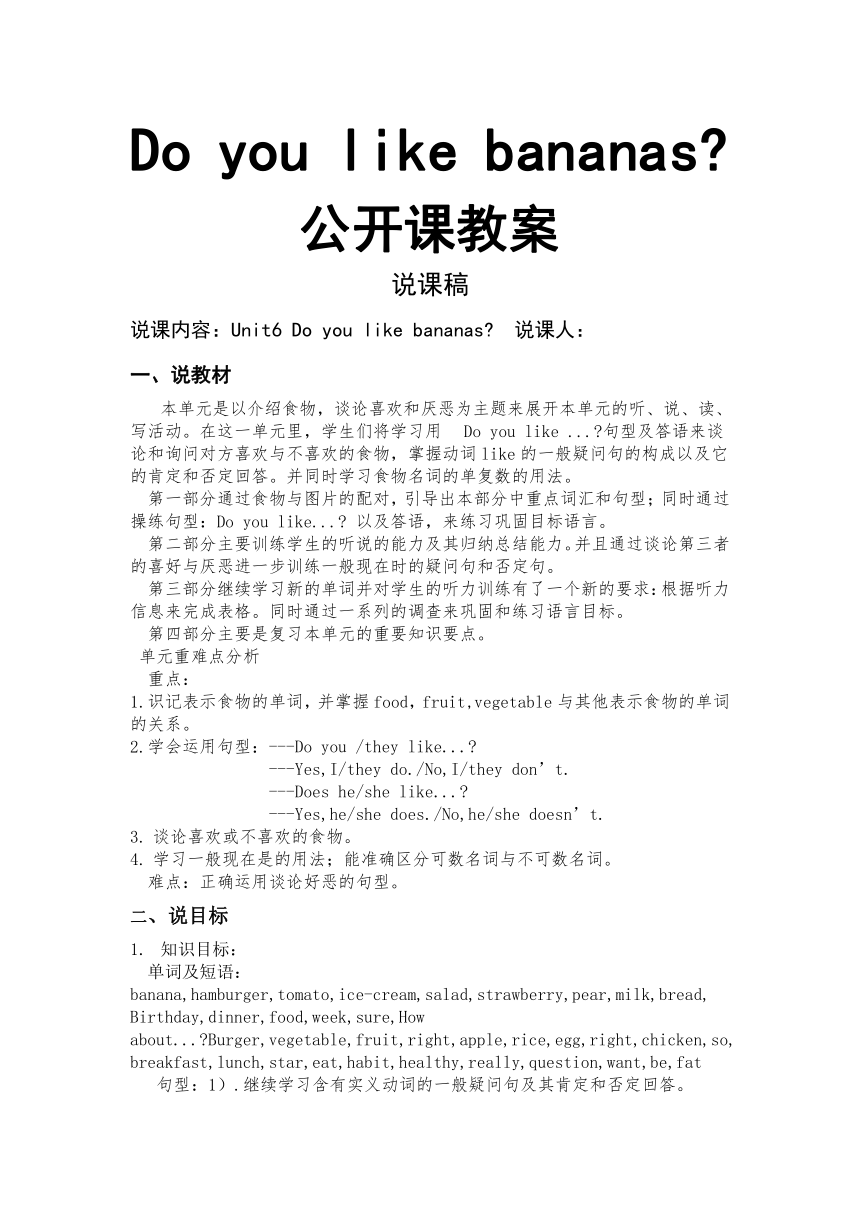 | |
| 格式 | zip | ||
| 文件大小 | 282.5KB | ||
| 资源类型 | 教案 | ||
| 版本资源 | 人教新目标(Go for it)版 | ||
| 科目 | 英语 | ||
| 更新时间 | 2020-11-20 14:50:49 | ||
图片预览

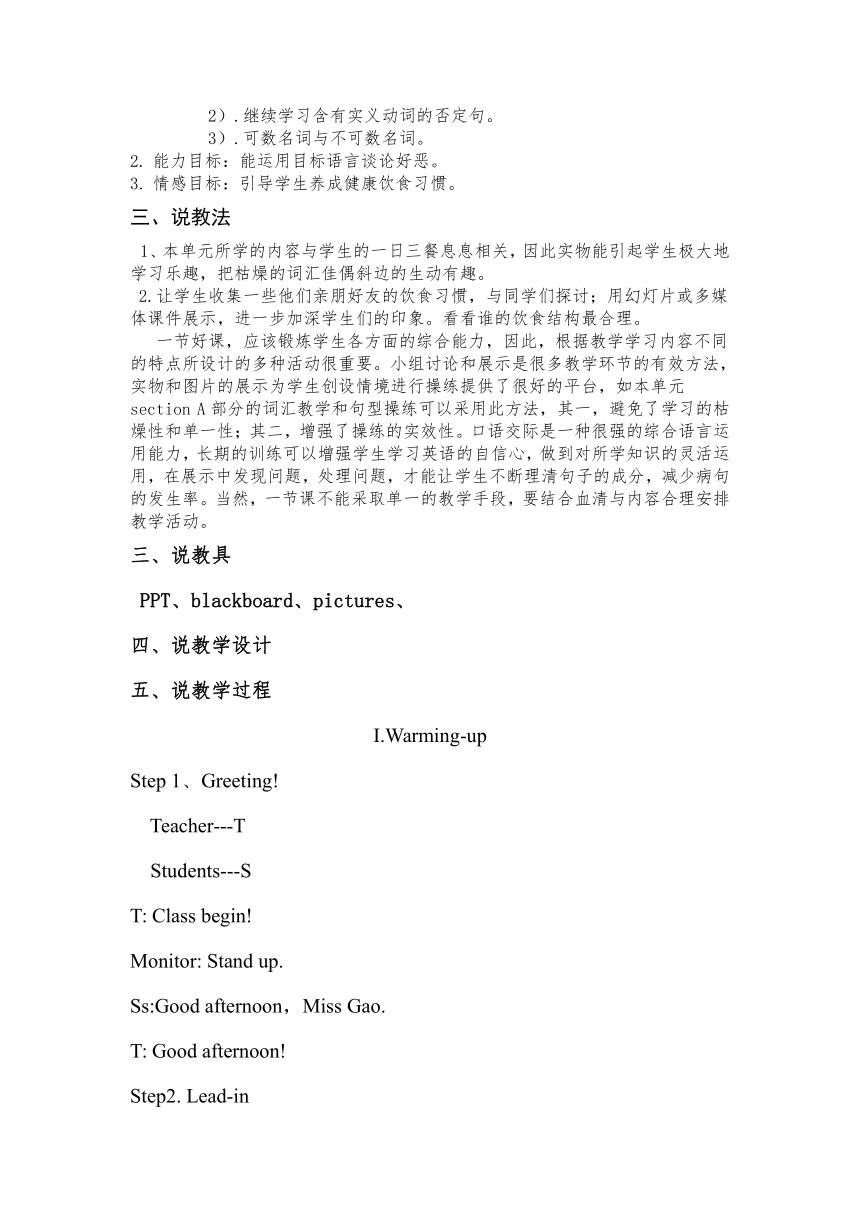
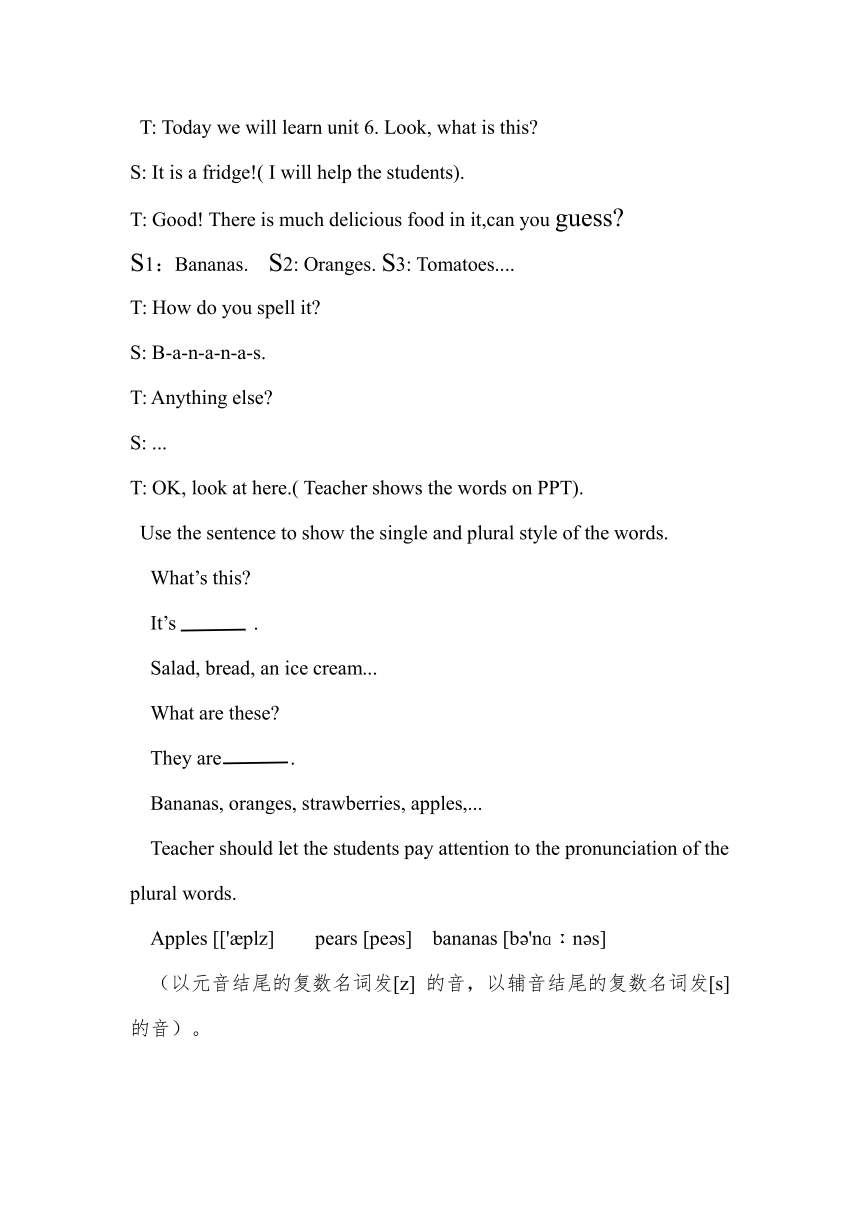
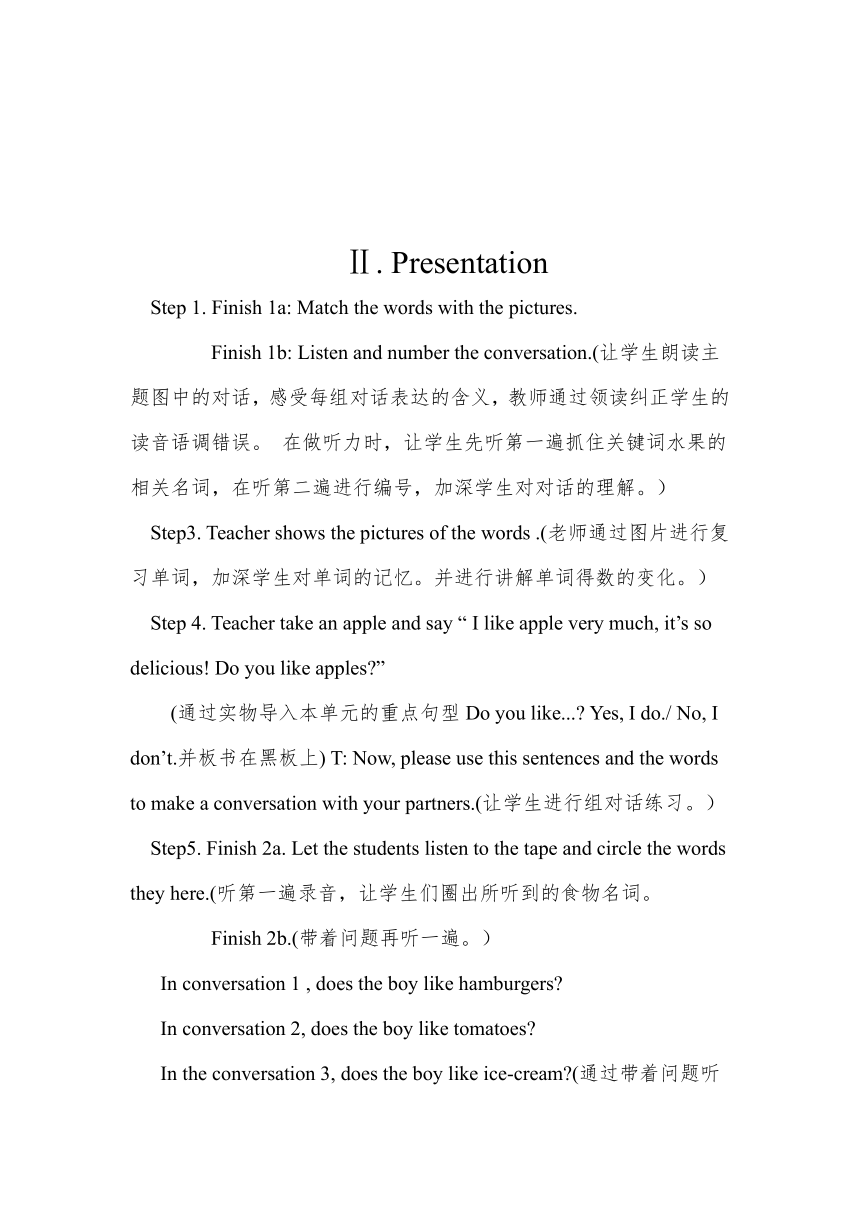
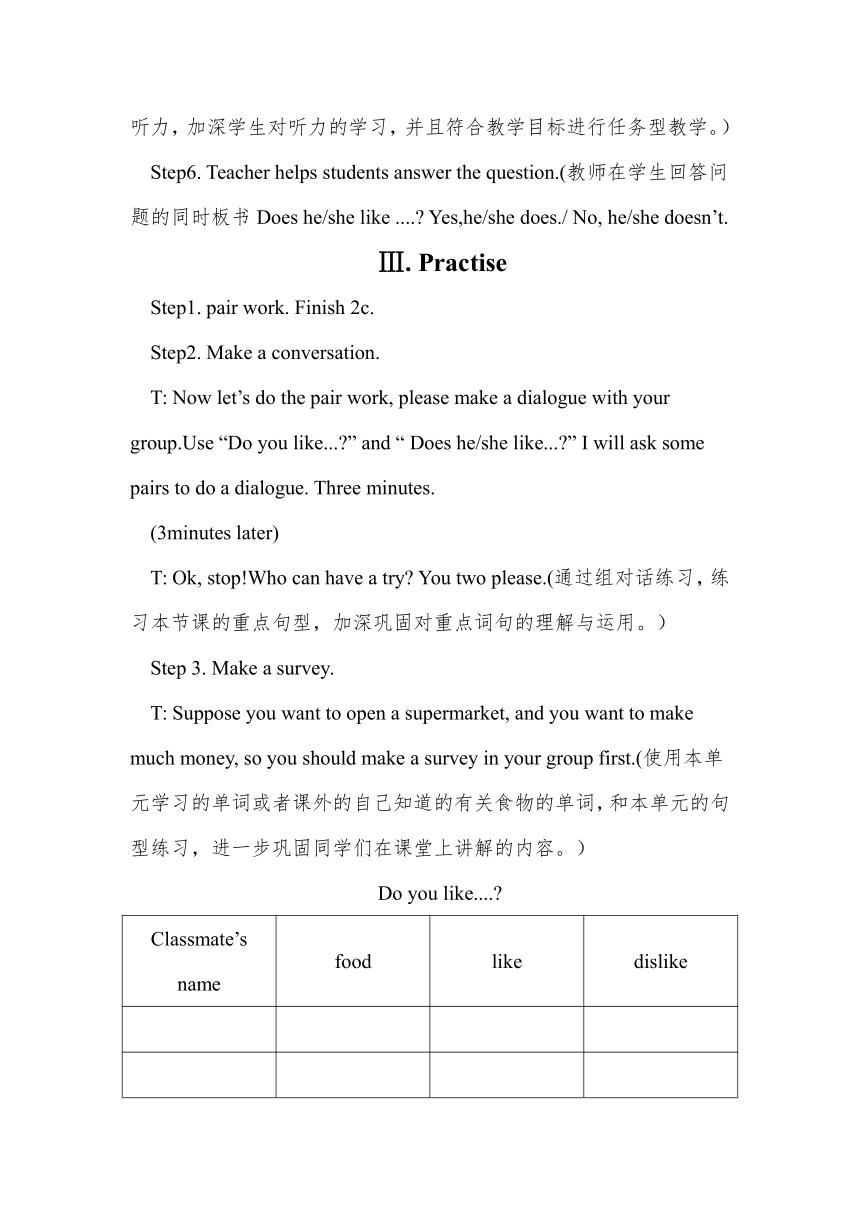
文档简介
Do
you
like
bananas?
公开课教案
说课稿
说课内容:Unit6
Do
you
like
bananas?
说课人:
1、说教材
本单元是以介绍食物,谈论喜欢和厌恶为主题来展开本单元的听、说、读、写活动。在这一单元里,学生们将学习用
Do
you
like
...?句型及答语来谈论和询问对方喜欢与不喜欢的食物,掌握动词like的一般疑问句的构成以及它的肯定和否定回答。并同时学习食物名词的单复数的用法。
第一部分通过食物与图片的配对,引导出本部分中重点词汇和句型;同时通过操练句型:Do
you
like...?
以及答语,来练习巩固目标语言。
第二部分主要训练学生的听说的能力及其归纳总结能力。并且通过谈论第三者的喜好与厌恶进一步训练一般现在时的疑问句和否定句。
第三部分继续学习新的单词并对学生的听力训练有了一个新的要求:根据听力信息来完成表格。同时通过一系列的调查来巩固和练习语言目标。
第四部分主要是复习本单元的重要知识要点。
单元重难点分析
重点:
1.识记表示食物的单词,并掌握food,fruit,vegetable与其他表示食物的单词的关系。
2.学会运用句型:---Do
you
/they
like...?
---Yes,I/they
do./No,I/they
don’t.
---Does
he/she
like...?
---Yes,he/she
does./No,he/she
doesn’t.
3.
谈论喜欢或不喜欢的食物。
4.
学习一般现在是的用法;能准确区分可数名词与不可数名词。
难点:正确运用谈论好恶的句型。
二、说目标
1.
知识目标:
单词及短语:banana,hamburger,tomato,ice-cream,salad,strawberry,pear,milk,bread,
Birthday,dinner,food,week,sure,How
about...?Burger,vegetable,fruit,right,apple,rice,egg,right,chicken,so,breakfast,lunch,star,eat,habit,healthy,really,question,want,be,fat
句型:1).继续学习含有实义动词的一般疑问句及其肯定和否定回答。
2).继续学习含有实义动词的否定句。
3).可数名词与不可数名词。
2.
能力目标:能运用目标语言谈论好恶。
3.
情感目标:引导学生养成健康饮食习惯。
3、说教法
1、本单元所学的内容与学生的一日三餐息息相关,因此实物能引起学生极大地学习乐趣,把枯燥的词汇佳偶斜边的生动有趣。
2.让学生收集一些他们亲朋好友的饮食习惯,与同学们探讨;用幻灯片或多媒体课件展示,进一步加深学生们的印象。看看谁的饮食结构最合理。
一节好课,应该锻炼学生各方面的综合能力,因此,根据教学学习内容不同的特点所设计的多种活动很重要。小组讨论和展示是很多教学环节的有效方法,实物和图片的展示为学生创设情境进行操练提供了很好的平台,如本单元section
A部分的词汇教学和句型操练可以采用此方法,其一,避免了学习的枯燥性和单一性;其二,增强了操练的实效性。口语交际是一种很强的综合语言运用能力,长期的训练可以增强学生学习英语的自信心,做到对所学知识的灵活运用,在展示中发现问题,处理问题,才能让学生不断理清句子的成分,减少病句的发生率。当然,一节课不能采取单一的教学手段,要结合血清与内容合理安排教学活动。
3、说教具
PPT、blackboard、pictures、
4、说教学设计
5、说教学过程
Ⅰ.Warming-up
Step
1、Greeting!
Teacher---T
Students---S
T:
Class
begin!
Monitor:
Stand
up.
Ss:Good
afternoon,Miss
Gao.
T:
Good
afternoon!
Step2.
Lead-in
T:
Today
we
will
learn
unit
6.
Look,
what
is
this?
S:
It
is
a
fridge!(
I
will
help
the
students).
T:
Good!
There
is
much
delicious
food
in
it,can
you
guess?
S1:Bananas.
S2:
Oranges.
S3:
Tomatoes....
T:
How
do
you
spell
it?
S:
B-a-n-a-n-a-s.
T:
Anything
else?
S:
...
T:
OK,
look
at
here.(
Teacher
shows
the
words
on
PPT).
Use
the
sentence
to
show
the
single
and
plural
style
of
the
words.
What’s
this?
It’s
.
Salad,
bread,
an
ice
cream...
What
are
these?
They
are
.
Bananas,
oranges,
strawberries,
apples,...
Teacher
should
let
the
students
pay
attention
to
the
pronunciation
of
the
plural
words.
Apples
[['?plz]
pears
[pe?s]
bananas
[b?'nɑ?n?s]
(以元音结尾的复数名词发[z]
的音,以辅音结尾的复数名词发[s]的音)。
Ⅱ.
Presentation
Step
1.
Finish
1a:
Match
the
words
with
the
pictures.
Finish
1b:
Listen
and
number
the
conversation.(让学生朗读主题图中的对话,感受每组对话表达的含义,教师通过领读纠正学生的读音语调错误。
在做听力时,让学生先听第一遍抓住关键词水果的相关名词,在听第二遍进行编号,加深学生对对话的理解。)
Step3.
Teacher
shows
the
pictures
of
the
words
.(老师通过图片进行复习单词,加深学生对单词的记忆。并进行讲解单词得数的变化。)
Step
4.
Teacher
take
an
apple
and
say
“
I
like
apple
very
much,
it’s
so
delicious!
Do
you
like
apples?”
(通过实物导入本单元的重点句型Do
you
like...?
Yes,
I
do./
No,
I
don’t.并板书在黑板上)
T:
Now,
please
use
this
sentences
and
the
words
to
make
a
conversation
with
your
partners.(让学生进行组对话练习。)
Step5.
Finish
2a.
Let
the
students
listen
to
the
tape
and
circle
the
words
they
here.(听第一遍录音,让学生们圈出所听到的食物名词。
Finish
2b.(带着问题再听一遍。)
In
conversation
1
,
does
the
boy
like
hamburgers?
In
conversation
2,
does
the
boy
like
tomatoes?
In
the
conversation
3,
does
the
boy
like
ice-cream?(通过带着问题听听力,加深学生对听力的学习,并且符合教学目标进行任务型教学。)
Step6.
Teacher
helps
students
answer
the
question.(教师在学生回答问题的同时板书Does
he/she
like
....?
Yes,he/she
does./
No,
he/she
doesn’t.
Ⅲ.
Practise
Step1.
pair
work.
Finish
2c.
Step2.
Make
a
conversation.
T:
Now
let’s
do
the
pair
work,
please
make
a
dialogue
with
your
group.Use
“Do
you
like...?”
and
“
Does
he/she
like...?”
I
will
ask
some
pairs
to
do
a
dialogue.
Three
minutes.
(3minutes
later)
T:
Ok,
stop!Who
can
have
a
try?
You
two
please.(通过组对话练习,练习本节课的重点句型,加深巩固对重点词句的理解与运用。)
Step
3.
Make
a
survey.
T:
Suppose
you
want
to
open
a
supermarket,
and
you
want
to
make
much
money,
so
you
should
make
a
survey
in
your
group
first.(使用本单元学习的单词或者课外的自己知道的有关食物的单词,和本单元的句型练习,进一步巩固同学们在课堂上讲解的内容。)
Do
you
like....?
Classmate’s
name
food
like
dislike
Step4.
Do
a
practise.(做ppt上的练习题,对学生们进行题型巩固,运用在题型上)
Homework:
1.
Review
the
words
they
have
learned
in
this
class.
2.
写小短文,询问自己的家人,他们喜欢和不喜欢的食物。
3.
背诵单词。
Blackboard
Design:
Unit
6
Do
you
like
bananas?
Section
A
1a-2c
Do
you
like
...?
Yes,
I
do./
No,
I
don’t.
Does
he/she
like
....?
Yes,he/she
does./
No,
he/she
doesn’t.
教学设计:
Ⅰ.Warming-up
Step
1、Greeting!
Teacher---T
Students---S
T:
Class
begin!
Monitor:
Stand
up.
Ss:Good
afternoon,Miss
Gao.
T:
Good
afternoon!
Step2.
Lead-in
T:
Today
we
will
learn
unit
6.
Look,
what
is
this?
S:
It
is
a
fridge!(
I
will
help
the
students).
T:
Good!
There
is
much
delicious
food
in
it,can
you
guess?
S1:Bananas.
S2:
Oranges.
S3:
Tomatoes....
T:
How
do
you
spell
it?
S:
B-a-n-a-n-a-s.
T:
Anything
else?
S:
...
T:
OK,
look
at
here.(
Teacher
shows
the
words
on
PPT).
Use
the
sentence
to
show
the
single
and
plural
style
of
the
words.
What’s
this?
It’s
.
Salad,
bread,
an
ice
cream...
What
are
these?
They
are
.
Bananas,
oranges,
strawberries,
apples,...
Teacher
should
let
the
students
pay
attention
to
the
pronunciation
of
the
plural
words.
Apples
[['?plz]
pears
[pe?s]
bananas
[b?'nɑ?n?s]
(以元音结尾的复数名词发[z]
的音,以辅音结尾的复数名词发[s]的音)。
Ⅱ.
Presentation
Step
1.
Finish
1a:
Match
the
words
with
the
pictures.
Finish
1b:
Listen
and
number
the
conversation.(让学生朗读主题图中的对话,感受每组对话表达的含义,教师通过领读纠正学生的读音语调错误。
在做听力时,让学生先听第一遍抓住关键词水果的相关名词,在听第二遍进行编号,加深学生对对话的理解。)
Step3.
Teacher
shows
the
pictures
of
the
words
.(老师通过图片进行复习单词,加深学生对单词的记忆。并进行讲解单词得数的变化。)
Step
4.
Teacher
take
an
apple
and
say
“
I
like
apple
very
much,
it’s
so
delicious!
Do
you
like
apples?”
(通过实物导入本单元的重点句型Do
you
like...?
Yes,
I
do./
No,
I
don’t.并板书在黑板上)
T:
Now,
please
use
this
sentences
and
the
words
to
make
a
conversation
with
your
partners.(让学生进行组对话练习。)
Step5.
Finish
2a.
Let
the
students
listen
to
the
tape
and
circle
the
words
they
here.(听第一遍录音,让学生们圈出所听到的食物名词。
Finish
2b.(带着问题再听一遍。)
In
conversation
1
,
does
the
boy
like
hamburgers?
In
conversation
2,
does
the
boy
like
tomatoes?
In
the
conversation
3,
does
the
boy
like
ice-cream?(通过带着问题听听力,加深学生对听力的学习,并且符合教学目标进行任务型教学。)
Step6.
Teacher
helps
students
answer
the
question.(教师在学生回答问题的同时板书Does
he/she
like
....?
Yes,he/she
does./
No,
he/she
doesn’t.
Ⅲ.
Practise
Step1.
pair
work.
Finish
2c.
Step2.
Make
a
conversation.
T:
Now
let’s
do
the
pair
work,
please
make
a
dialogue
with
your
group.Use
“Do
you
like...?”
and
“
Does
he/she
like...?”
I
will
ask
some
pairs
to
do
a
dialogue.
Three
minutes.
(3minutes
later)
T:
Ok,
stop!Who
can
have
a
try?
You
two
please.(通过组对话练习,练习本节课的重点句型,加深巩固对重点词句的理解与运用。)
Step
3.
Make
a
survey.
T:
Suppose
you
want
to
open
a
supermarket,
and
you
want
to
make
much
money,
so
you
should
make
a
survey
in
your
group
first.(使用本单元学习的单词或者课外的自己知道的有关食物的单词,和本单元的句型练习,进一步巩固同学们在课堂上讲解的内容。)
Do
you
like....?
Classmate’s
name
food
like
dislike
Step4.
Do
a
practise.(做ppt上的练习题,对学生们进行题型巩固,运用在题型上)
Homework:
1.
Review
the
words
they
have
learned
in
this
class.
2.
写小短文,询问自己的家人,他们喜欢和不喜欢的食物。
3.
背诵单词。
Blackboard
Design:
Unit
6
Do
you
like
bananas?
Section
A
1a-2c
Do
you
like
...?
Yes,
I
do./
No,
I
don’t.
Does
he/she
like
....?
Yes,he/she
does./
No,
he/she
doesn’t.
you
like
bananas?
公开课教案
说课稿
说课内容:Unit6
Do
you
like
bananas?
说课人:
1、说教材
本单元是以介绍食物,谈论喜欢和厌恶为主题来展开本单元的听、说、读、写活动。在这一单元里,学生们将学习用
Do
you
like
...?句型及答语来谈论和询问对方喜欢与不喜欢的食物,掌握动词like的一般疑问句的构成以及它的肯定和否定回答。并同时学习食物名词的单复数的用法。
第一部分通过食物与图片的配对,引导出本部分中重点词汇和句型;同时通过操练句型:Do
you
like...?
以及答语,来练习巩固目标语言。
第二部分主要训练学生的听说的能力及其归纳总结能力。并且通过谈论第三者的喜好与厌恶进一步训练一般现在时的疑问句和否定句。
第三部分继续学习新的单词并对学生的听力训练有了一个新的要求:根据听力信息来完成表格。同时通过一系列的调查来巩固和练习语言目标。
第四部分主要是复习本单元的重要知识要点。
单元重难点分析
重点:
1.识记表示食物的单词,并掌握food,fruit,vegetable与其他表示食物的单词的关系。
2.学会运用句型:---Do
you
/they
like...?
---Yes,I/they
do./No,I/they
don’t.
---Does
he/she
like...?
---Yes,he/she
does./No,he/she
doesn’t.
3.
谈论喜欢或不喜欢的食物。
4.
学习一般现在是的用法;能准确区分可数名词与不可数名词。
难点:正确运用谈论好恶的句型。
二、说目标
1.
知识目标:
单词及短语:banana,hamburger,tomato,ice-cream,salad,strawberry,pear,milk,bread,
Birthday,dinner,food,week,sure,How
about...?Burger,vegetable,fruit,right,apple,rice,egg,right,chicken,so,breakfast,lunch,star,eat,habit,healthy,really,question,want,be,fat
句型:1).继续学习含有实义动词的一般疑问句及其肯定和否定回答。
2).继续学习含有实义动词的否定句。
3).可数名词与不可数名词。
2.
能力目标:能运用目标语言谈论好恶。
3.
情感目标:引导学生养成健康饮食习惯。
3、说教法
1、本单元所学的内容与学生的一日三餐息息相关,因此实物能引起学生极大地学习乐趣,把枯燥的词汇佳偶斜边的生动有趣。
2.让学生收集一些他们亲朋好友的饮食习惯,与同学们探讨;用幻灯片或多媒体课件展示,进一步加深学生们的印象。看看谁的饮食结构最合理。
一节好课,应该锻炼学生各方面的综合能力,因此,根据教学学习内容不同的特点所设计的多种活动很重要。小组讨论和展示是很多教学环节的有效方法,实物和图片的展示为学生创设情境进行操练提供了很好的平台,如本单元section
A部分的词汇教学和句型操练可以采用此方法,其一,避免了学习的枯燥性和单一性;其二,增强了操练的实效性。口语交际是一种很强的综合语言运用能力,长期的训练可以增强学生学习英语的自信心,做到对所学知识的灵活运用,在展示中发现问题,处理问题,才能让学生不断理清句子的成分,减少病句的发生率。当然,一节课不能采取单一的教学手段,要结合血清与内容合理安排教学活动。
3、说教具
PPT、blackboard、pictures、
4、说教学设计
5、说教学过程
Ⅰ.Warming-up
Step
1、Greeting!
Teacher---T
Students---S
T:
Class
begin!
Monitor:
Stand
up.
Ss:Good
afternoon,Miss
Gao.
T:
Good
afternoon!
Step2.
Lead-in
T:
Today
we
will
learn
unit
6.
Look,
what
is
this?
S:
It
is
a
fridge!(
I
will
help
the
students).
T:
Good!
There
is
much
delicious
food
in
it,can
you
guess?
S1:Bananas.
S2:
Oranges.
S3:
Tomatoes....
T:
How
do
you
spell
it?
S:
B-a-n-a-n-a-s.
T:
Anything
else?
S:
...
T:
OK,
look
at
here.(
Teacher
shows
the
words
on
PPT).
Use
the
sentence
to
show
the
single
and
plural
style
of
the
words.
What’s
this?
It’s
.
Salad,
bread,
an
ice
cream...
What
are
these?
They
are
.
Bananas,
oranges,
strawberries,
apples,...
Teacher
should
let
the
students
pay
attention
to
the
pronunciation
of
the
plural
words.
Apples
[['?plz]
pears
[pe?s]
bananas
[b?'nɑ?n?s]
(以元音结尾的复数名词发[z]
的音,以辅音结尾的复数名词发[s]的音)。
Ⅱ.
Presentation
Step
1.
Finish
1a:
Match
the
words
with
the
pictures.
Finish
1b:
Listen
and
number
the
conversation.(让学生朗读主题图中的对话,感受每组对话表达的含义,教师通过领读纠正学生的读音语调错误。
在做听力时,让学生先听第一遍抓住关键词水果的相关名词,在听第二遍进行编号,加深学生对对话的理解。)
Step3.
Teacher
shows
the
pictures
of
the
words
.(老师通过图片进行复习单词,加深学生对单词的记忆。并进行讲解单词得数的变化。)
Step
4.
Teacher
take
an
apple
and
say
“
I
like
apple
very
much,
it’s
so
delicious!
Do
you
like
apples?”
(通过实物导入本单元的重点句型Do
you
like...?
Yes,
I
do./
No,
I
don’t.并板书在黑板上)
T:
Now,
please
use
this
sentences
and
the
words
to
make
a
conversation
with
your
partners.(让学生进行组对话练习。)
Step5.
Finish
2a.
Let
the
students
listen
to
the
tape
and
circle
the
words
they
here.(听第一遍录音,让学生们圈出所听到的食物名词。
Finish
2b.(带着问题再听一遍。)
In
conversation
1
,
does
the
boy
like
hamburgers?
In
conversation
2,
does
the
boy
like
tomatoes?
In
the
conversation
3,
does
the
boy
like
ice-cream?(通过带着问题听听力,加深学生对听力的学习,并且符合教学目标进行任务型教学。)
Step6.
Teacher
helps
students
answer
the
question.(教师在学生回答问题的同时板书Does
he/she
like
....?
Yes,he/she
does./
No,
he/she
doesn’t.
Ⅲ.
Practise
Step1.
pair
work.
Finish
2c.
Step2.
Make
a
conversation.
T:
Now
let’s
do
the
pair
work,
please
make
a
dialogue
with
your
group.Use
“Do
you
like...?”
and
“
Does
he/she
like...?”
I
will
ask
some
pairs
to
do
a
dialogue.
Three
minutes.
(3minutes
later)
T:
Ok,
stop!Who
can
have
a
try?
You
two
please.(通过组对话练习,练习本节课的重点句型,加深巩固对重点词句的理解与运用。)
Step
3.
Make
a
survey.
T:
Suppose
you
want
to
open
a
supermarket,
and
you
want
to
make
much
money,
so
you
should
make
a
survey
in
your
group
first.(使用本单元学习的单词或者课外的自己知道的有关食物的单词,和本单元的句型练习,进一步巩固同学们在课堂上讲解的内容。)
Do
you
like....?
Classmate’s
name
food
like
dislike
Step4.
Do
a
practise.(做ppt上的练习题,对学生们进行题型巩固,运用在题型上)
Homework:
1.
Review
the
words
they
have
learned
in
this
class.
2.
写小短文,询问自己的家人,他们喜欢和不喜欢的食物。
3.
背诵单词。
Blackboard
Design:
Unit
6
Do
you
like
bananas?
Section
A
1a-2c
Do
you
like
...?
Yes,
I
do./
No,
I
don’t.
Does
he/she
like
....?
Yes,he/she
does./
No,
he/she
doesn’t.
教学设计:
Ⅰ.Warming-up
Step
1、Greeting!
Teacher---T
Students---S
T:
Class
begin!
Monitor:
Stand
up.
Ss:Good
afternoon,Miss
Gao.
T:
Good
afternoon!
Step2.
Lead-in
T:
Today
we
will
learn
unit
6.
Look,
what
is
this?
S:
It
is
a
fridge!(
I
will
help
the
students).
T:
Good!
There
is
much
delicious
food
in
it,can
you
guess?
S1:Bananas.
S2:
Oranges.
S3:
Tomatoes....
T:
How
do
you
spell
it?
S:
B-a-n-a-n-a-s.
T:
Anything
else?
S:
...
T:
OK,
look
at
here.(
Teacher
shows
the
words
on
PPT).
Use
the
sentence
to
show
the
single
and
plural
style
of
the
words.
What’s
this?
It’s
.
Salad,
bread,
an
ice
cream...
What
are
these?
They
are
.
Bananas,
oranges,
strawberries,
apples,...
Teacher
should
let
the
students
pay
attention
to
the
pronunciation
of
the
plural
words.
Apples
[['?plz]
pears
[pe?s]
bananas
[b?'nɑ?n?s]
(以元音结尾的复数名词发[z]
的音,以辅音结尾的复数名词发[s]的音)。
Ⅱ.
Presentation
Step
1.
Finish
1a:
Match
the
words
with
the
pictures.
Finish
1b:
Listen
and
number
the
conversation.(让学生朗读主题图中的对话,感受每组对话表达的含义,教师通过领读纠正学生的读音语调错误。
在做听力时,让学生先听第一遍抓住关键词水果的相关名词,在听第二遍进行编号,加深学生对对话的理解。)
Step3.
Teacher
shows
the
pictures
of
the
words
.(老师通过图片进行复习单词,加深学生对单词的记忆。并进行讲解单词得数的变化。)
Step
4.
Teacher
take
an
apple
and
say
“
I
like
apple
very
much,
it’s
so
delicious!
Do
you
like
apples?”
(通过实物导入本单元的重点句型Do
you
like...?
Yes,
I
do./
No,
I
don’t.并板书在黑板上)
T:
Now,
please
use
this
sentences
and
the
words
to
make
a
conversation
with
your
partners.(让学生进行组对话练习。)
Step5.
Finish
2a.
Let
the
students
listen
to
the
tape
and
circle
the
words
they
here.(听第一遍录音,让学生们圈出所听到的食物名词。
Finish
2b.(带着问题再听一遍。)
In
conversation
1
,
does
the
boy
like
hamburgers?
In
conversation
2,
does
the
boy
like
tomatoes?
In
the
conversation
3,
does
the
boy
like
ice-cream?(通过带着问题听听力,加深学生对听力的学习,并且符合教学目标进行任务型教学。)
Step6.
Teacher
helps
students
answer
the
question.(教师在学生回答问题的同时板书Does
he/she
like
....?
Yes,he/she
does./
No,
he/she
doesn’t.
Ⅲ.
Practise
Step1.
pair
work.
Finish
2c.
Step2.
Make
a
conversation.
T:
Now
let’s
do
the
pair
work,
please
make
a
dialogue
with
your
group.Use
“Do
you
like...?”
and
“
Does
he/she
like...?”
I
will
ask
some
pairs
to
do
a
dialogue.
Three
minutes.
(3minutes
later)
T:
Ok,
stop!Who
can
have
a
try?
You
two
please.(通过组对话练习,练习本节课的重点句型,加深巩固对重点词句的理解与运用。)
Step
3.
Make
a
survey.
T:
Suppose
you
want
to
open
a
supermarket,
and
you
want
to
make
much
money,
so
you
should
make
a
survey
in
your
group
first.(使用本单元学习的单词或者课外的自己知道的有关食物的单词,和本单元的句型练习,进一步巩固同学们在课堂上讲解的内容。)
Do
you
like....?
Classmate’s
name
food
like
dislike
Step4.
Do
a
practise.(做ppt上的练习题,对学生们进行题型巩固,运用在题型上)
Homework:
1.
Review
the
words
they
have
learned
in
this
class.
2.
写小短文,询问自己的家人,他们喜欢和不喜欢的食物。
3.
背诵单词。
Blackboard
Design:
Unit
6
Do
you
like
bananas?
Section
A
1a-2c
Do
you
like
...?
Yes,
I
do./
No,
I
don’t.
Does
he/she
like
....?
Yes,he/she
does./
No,
he/she
doesn’t.
同课章节目录
- starters 预备篇(2012秋审查)
- Unit 1 Good morning !
- Unit 2 What’s this in English?
- Unit 3 What color is it ?
- Unit 1 My name's Gina.
- Section A
- Section B
- Unit 2 This is my sister.
- Section A
- Section B
- Unit 3 Is this your pencil?
- Section A
- Section B
- Unit 4 Where's my schoolbag?
- Section A
- Section B
- Unit 5 Do you have a soccer ball?
- Section A
- Section B
- Unit 6 Do you like bananas?
- Section A
- Section B
- Unit 7 How much are these socks?
- Section A
- Section B
- Unit 8 When is your birthday?
- Section A
- Section B
- Unit 9 My favorite subject is science.
- Section A
- Section B
